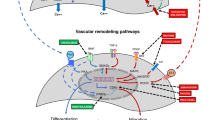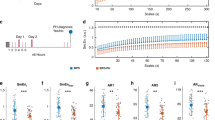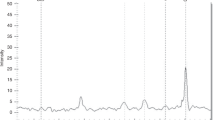Abstract
Background
Pulmonary hypertension (PH) in patients with bronchopulmonary dysplasia (BPD) results from vasoconstriction and/or vascular remodeling, which can be regulated by mitogen-activated protein kinases (MAPKs). MAPKs are deactivated by dual-specificity phosphatases (DUSPs). We hypothesized that single-nucleotide polymorphisms (SNPs) in DUSP genes could be used to predict PH in BPD.
Methods
Preterm infants diagnosed with BPD (n = 188) were studied. PH was defined by echocardiographic criteria. Genomic DNA isolated from patient blood samples was analyzed for 31 SNPs in DUSP genes. Clinical characteristics and minor allele frequencies were compared between BPD-PH (cases) and BPD-without PH (control) groups. Biomarker models to predict PH in BPD using clinical and SNP data were tested by calculations of area under the ROC curve.
Results
In our BPD cohort, 32% (n = 61) had PH. Of the DUSP SNPs evaluated, DUSP1 SNP rs322351 was less common, and DUSP5 SNPs rs1042606 and rs3793892 were more common in cases than in controls. The best fit biomarker model combines clinical and DUSP genetic data with an area under the ROC curve of 0.76.
Conclusion
We identified three DUSP SNPs as potential BPD-PH biomarkers. Combining clinical and DUSP genetic data yields the most robust predictor for PH in BPD.
Similar content being viewed by others
Log in or create a free account to read this content
Gain free access to this article, as well as selected content from this journal and more on nature.com
or
References
Baker, C. D., Abman, S. H. & Mourani, P. M. Pulmonary hypertension in preterm infants with bronchopulmonary dysplasia. Pediatr. Allergy Immunol. Pulmonol. 27, 8–16 (2014).
Kalikkot Thekkeveedu, R., Guaman, M. C. & Shivanna, B. Bronchopulmonary dysplasia: a review of pathogenesis and pathophysiology. Respir. Med. 132, 170–177 (2017).
Berkelhamer, S. K., Mestan, K. K. & Steinhorn, R. H. Pulmonary hypertension in bronchopulmonary dysplasia. Semin. Perinatol. 37, 124–131 (2013).
Arjaans, S. et al. Identification of gaps in the current knowledge on pulmonary hypertension in extremely preterm infants: a systematic review and meta-analysis. Paediatr. Perinat. Epidemiol. 32, 258–267 (2018).
Li, L., Chen, S. F. & Liu, Y. MAP kinase phosphatase-1, a critical negative regulator of the innate immune response. Int. J. Clin. Exp. Med. 2, 48–67 (2009).
Dickinson, R. J. & Keyse, S. M. Diverse physiological functions for dual-specificity MAP kinase phosphatases. J. Cell Sci. 119, 4607–4615 (2006).
Huang, C. Y. & Tan, T. H. DUSPs, to MAP kinases and beyond. Cell Biosci. 2, 1–10 (2012).
Wilson, J. L., Yu, J., Taylor, L. & Polgar, P. Hyperplastic growth of pulmonary artery smooth muscle cells from subjects with pulmonary arterial hypertension is activated through JNK and p38 MAPK. PLoS ONE 10, e0123662 (2015).
Kojonazarov, B. et al. p38 MAPK inhibition improves heart function in pressure-loaded right ventricular hypertrophy. Am. J. Respir. Cell Mol. Biol. 57, 603–614 (2017).
Jin, Y. et al. Mice deficient in Mkp-1 develop more severe pulmonary hypertension and greater lung protein levels of arginase in response to chronic hypoxia. Am. J. Physiol. Heart Circ. Physiol. 298, H1518–H1528 (2010).
Jin, Y. et al. MKP-1 is a target of miR-210 and mediate the negative regulation of miR-210 inhibitor on hypoxic hPASMC proliferation. Cell Biol. Int. 39, 113–120 (2015).
Jobe, A. H. & Bancalari, E. Bronchopulmonary dysplasia. Am. J. Respir. Crit. Care Med. 163, 1723–1729 (2001).
Walsh, M. C., Wilson-Costello, D., Zadell, A., Newman, N. & Fanaroff, A. Safety, reliability, and validity of a physiologic definition of bronchopulmonary dysplasia. J. Perinatol. 23, 451–456 (2003).
Trittmann, J. K. et al. Using clinical and genetic data to predict pulmonary hypertension in bronchopulmonary dysplasia. Acta Paediatr. 107, 2158–2164 (2018).
Bui, C. B. et al. Pulmonary hypertension associated with bronchopulmonary dysplasia in preterm infants. J. Reprod. Immunol. 124, 21–29 (2017).
Slaughter, J. L., Pakrashi, T., Jones, D. E., South, A. P. & Shah, T. A. Echocardiographic detection of pulmonary hypertension in extremely low birth weight infants with bronchopulmonary dysplasia requiring prolonged positive pressure ventilation. J. Perinatol. 31, 635–640 (2011).
Trittmann, J. K. et al. A single nucleotide polymorphism in the dimethylarginine dimethylaminohydrolase gene is associated with lower risk of pulmonary hypertension in bronchopulmonary dysplasia. Acta Paediatr. 105, e170–e175 (2016).
Trittmann, J. K. et al. Arginase I gene single-nucleotide polymorphism is associated with decreased risk of pulmonary hypertension in bronchopulmonary dysplasia. Acta Paediatr. 103, e439–e443 (2014).
Trittmann, J. K. et al. Plasma asymmetric dimethylarginine levels are increased in neonates with bronchopulmonary dysplasia-associated pulmonary hypertension. J. Pediatr. 166, 230–233 (2015).
Pearson, D. L. et al. Neonatal pulmonary hypertension-urea-cycle intermediates, nitric oxide production, and carbamoyl-phosphate synthetase function. N. Engl. J. Med. 344, 1832–1838 (2001).
Braga-Neto, U., Hashimoto, R., Dougherty, E. R., Nguyen, D. V. & Carroll, R. J. Is cross-validation better than resubstitution for ranking genes? Bioinformatics 20, 253–258 (2004).
Andres, S. A., Brock, G. N. & Wittliff, J. L. Interrogating differences in expression of targeted gene sets to predict breast cancer outcome. BMC Cancer 13, 1–18 (2013).
Garbett, N. C. & Brock, G. N. Differential scanning calorimetry as a complementary diagnostic tool for the evaluation of biological samples. Biochim. Biophys. Acta 1860, 981–989 (2016).
Lasa, M., Abraham, S. M., Boucheron, C., Saklatvala, J. & Clark, A. R. Dexamethasone causes sustained expression of mitogen-activated protein kinase (MAPK) phosphatase 1 and phosphatase-mediated inhibition of MAPK p38. Mol. Cell Biol. 22, 7802–7811 (2002).
Trittmann, J. K. et al. An arginase-1 SNP that protects against the development of pulmonary hypertension in bronchopulmonary dysplasia enhances NO-mediated apoptosis in lymphocytes. Physiol. Rep. 4, 1–11 (2016).
Furchgott, R. F. & Zawadzki, J. V. The obligatory role of endothelial cells in the relaxation of arterial smooth muscle by acetylcholine. Nature 288, 373–376 (1980).
Morris, S. M. Jr. & Billiar, T. R. New insights into the regulation of inducible nitric oxide synthesis. Am. J. Physiol. 266, E829–E839 (1994).
Kucharska, A., Rushworth, L. K., Staples, C., Morrice, N. A. & Keyse, S. M. Regulation of the inducible nuclear dual-specificity phosphatase DUSP5 by ERK MAPK. Cell Signal 21, 1794–1805 (2009).
Owens, D. M. & Keyse, S. M. Differential regulation of MAP kinase signalling by dual-specificity protein phosphatases. Oncogene 26, 3203–3213 (2007).
Mandl, M., Slack, D. N. & Keyse, S. M. Specific inactivation and nuclear anchoring of extracellular signal-regulated kinase 2 by the inducible dual-specificity protein phosphatase DUSP5. Mol. Cell Biol. 25, 1830–1845 (2005).
Franklin, C. C. & Kraft, A. S. Constitutively active MAP kinase kinase (MEK1) stimulates SAP kinase and c-Jun transcriptional activity in U937 human leukemic cells. Oncogene 11, 2365–2374 (1995).
Franklin, C. C. & Kraft, A. S. Conditional expression of the mitogen-activated protein kinase (MAPK) phosphatase MKP-1 preferentially inhibits p38 MAPK and stress-activated protein kinase in U937 cells. J. Biol. Chem. 272, 16917–16923 (1997).
Brondello, J. M., Pouyssegur, J. & McKenzie, F. R. Reduced MAP kinase phosphatase-1 degradation after p42/p44MAPK-dependent phosphorylation. Science 286, 2514–2517 (1999).
Lin, Y. W. & Yang, J. L. Cooperation of ERK and SCFSkp2 for MKP-1 destruction provides a positive feedback regulation of proliferating signaling. J. Biol. Chem. 281, 915–926 (2006).
Talavera, M. M. et al. Mitogen-activated protein kinase phosphatase-1 prevents lipopolysaccharide-induced apoptosis in immature rat intestinal epithelial cells. Pediatr. Res. 78, 128–136 (2015).
Li, B., Yang, L., Shen, J., Wang, C. & Jiang, Z. The antiproliferative effect of sildenafil on pulmonary artery smooth muscle cells is mediated via upregulation of mitogen-activated protein kinase phosphatase-1 and degradation of extracellular signal-regulated kinase 1/2 phosphorylation. Anesth. Analg. 105, 1034–1041 (2007).
Kovacs, L. et al. Activation of Calpain-2 by mediators in pulmonary vascular remodeling of pulmonary arterial hypertension. Am. J. Respir. Cell Mol. Biol. 54, 384–393 (2016).
Nelin, L. D. et al. The Src family tyrosine kinases src and yes have differential effects on inflammation-induced apoptosis in human pulmonary microvascular endothelial cells. Am. J. Physiol. Lung Cell Mol. Physiol. 310, L880–L888 (2016).
McCrary, A. W. et al. Agreement of an echocardiogram-based diagnosis of pulmonary hypertension in infants at risk for bronchopulmonary dysplasia among masked reviewers. J. Perinatol. 39, 248–255 (2018).
Acknowledgements
The authors would like to thank the patients and their families for participating in this study and the research staff of the Ohio Perinatal Research Network (OPRN) and the Perinatal Research Respository (PRR). This work was supported in part by The Ohio State University College of Medicine Roessler Medical Student Research Scholarship awarded to L.L.C. This study was funded by an intramural grant from the Center for Clinical and Translational Research at The Research Institute, Nationwide Children’s Hospital (CTSA grant UL1TR001070) and an NIH grant (K08HL129080) from NHLBI.
Author information
Authors and Affiliations
Contributions
Substantial contributions to conception and design, acquisition of data, or analysis and interpretation of data: all authors. Drafting the article or revising it critically for important intellectual content: L.L.C., J.K.T. Final approval of the version to be published: all authors.
Corresponding author
Ethics declarations
Competing interests
The authors declare no competing interests.
Additional information
Publisher’s note: Springer Nature remains neutral with regard to jurisdictional claims in published maps and institutional affiliations.
Rights and permissions
About this article
Cite this article
Chen, L.L., Zmuda, E.J., Talavera, M.M. et al. Dual-specificity phosphatase (DUSP) genetic variants predict pulmonary hypertension in patients with bronchopulmonary dysplasia. Pediatr Res 87, 81–87 (2020). https://doi.org/10.1038/s41390-019-0502-9
Received:
Revised:
Accepted:
Published:
Issue date:
DOI: https://doi.org/10.1038/s41390-019-0502-9
This article is cited by
-
Single nuclei RNA-sequencing unveils alveolar macrophages as drivers of endothelial damage in obese HFpEF-related pulmonary hypertension
Cardiovascular Diabetology (2025)
-
Phenotype wide association study links bronchopulmonary dysplasia with eosinophilia in children
Scientific Reports (2024)
-
Hyperoxia exposure upregulates Dvl-1 and activates Wnt/β-catenin signaling pathway in newborn rat lung
BMC Molecular and Cell Biology (2023)



